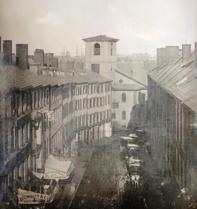Brattle Street (Boston)

This article is missing information about the eventual fate of the street. (April 2025) |
Brattle Street, which existed from 1694 to 1962, was a street in Boston, Massachusetts, located on the current site of City Hall Plaza, at Government Center.[1][2][3]
History
[edit]This section needs expansion. You can help by adding to it. (May 2012) |
John Adams and his family lived on this street for a year in 1768, and in another house in 1770, before moving to Braintree; he may have had a law practice in his house.[4][5]
Around 1853, former Virginia slave Anthony Burns worked for "Coffin Pitts, clothing dealer, no.36 Brattle Street."[6] Nearby, abolitionist John P. Coburn managed a clothing store at 20 Brattle Street.[7] In 1850, Joshua Bowen Smith, a black abolitionist and member of Boston's Vigilance Committee, operated a catering business at 16 Brattle Street."[8]
In 1921, the first Radio Shack store opened at 46 Brattle Street.[9][10]
Gallery
[edit]-
Detail of 1775 map of Boston, showing Brattle St. and vicinity
-
Shelton & Cheever, importers and manufacturers of "engine hose, fire buckets ... harnesses, collars, whips, carpet bags," 1852
-
Funeral of Abbott Lawrence, photo by Southworth & Hawes, 1855
-
Corner of Brattle and Court St., engraving by Winslow Homer, 1857
-
R. Marston & Co. Dining Rooms, ca.1881
-
Overview of Brattle St., ca.1920
-
Brattle Street, Boston, 1962
-
Brattle St., with steps to Cornhill, Boston, 1962
See also
[edit]References
[edit]- ^ Boston (Mass.). Street laying-out Dept. (1910), A record of the streets, alleys, places, etc. in the city of Boston (2nd ed.), Boston: City of Boston Printing Dept., OL 16574538M
- ^ Walter Muir Whitehill (1968), Boston: a topographical history (2nd ed.), Cambridge, Massachusetts: Belknap Press of Harvard University Press, ISBN 0674079507, OL 21601121M, 0674079507
- ^ David Kruh (1999), Always something doing: Boston's infamous Scollay Square (Rev. ed.), Boston: Northeastern University Press, ISBN 1555534104, 1555534104
- ^ "John Adams to John Quincy Adams, 13 September 1790". National Archives: Founders Online. Archived from the original on January 11, 2025. Retrieved April 5, 2025.
- ^ "Diary of John Adams, volume 2". Massachusetts Historical Society. Archived from the original on November 29, 2020. Retrieved April 5, 2025.
- ^ Boston slave riot, and trial of Anthony Burns: Containing the report of the Faneuil Hall meeting, the murder of Batchelder, Theodore Parker's Lesson for the day, speeches of counsel on both sides, corrected by themselves, a verbatim report of Judge Loring's decision, and detailed account of the embarkation, Boston: Fetridge and Company, 1854, OL 6948460M
- ^ Snodgrass, Mary Ellen (2015). "Coburn, John P.". The Underground Railroad: An Encyclopedia of People, Places, and Operations. Routledge. p. 123. ISBN 9781317454168.
- ^ "Universalist General Reform Association," Christian Freeman and Family Advertiser, June 7, 1850, page 2
- ^ Brustein, Joshua (February 2, 2015). "Inside RadioShack's Slow-Motion Collapse". Bloomberg. Archived from the original on February 11, 2015. Retrieved April 5, 2025.
- ^ "A Brief History of Radio Shack". RadioShack Catalogs. Archived from the original on April 24, 2024. Retrieved April 6, 2025.
External links
[edit]- Bostonian Society Archived 2010-05-09 at the Wayback Machine has materials related to Brattle Street.









